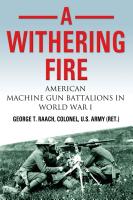| ||||||||||||
| Category: Military |
(requires Adobe Reader)
|
| About the Book | |
|
A Withering Fire is the definitive history of American machine gun battalions in World War I. It describes the creation of these battalions, their training, equipment, and combat employment through official documents and firsthand accounts of the men who served in these units. When the U.S. entered the war in April 1917 it had fewer than 450 machine guns, all of them obsolete, and no machine gun units larger than a platoon. In less than 17 months, the country produced nearly 50,000 modern machine guns, and the Army organized almost 200 proficient machine gun battalions. Their fire was a major force in combat. Machine gunners comprised only about 12 percent of an infantry divisionís strength, but delivered more than 65 percent of its fire power. A single machine gun was considered the equivalent of at least 100 riflemen. Realizing the value of machine guns somewhat belatedly, the Army demanded what it called scientific machine gunnery, and required its gunners to deliver accurate, sustained fire at long range not only on targets they could see, but also on those that were hidden by terrain or weather. To accomplish these missions and survive, machine gunners had to be part technician, part tactician, and part mathematician. Training was intensive, firing techniques were sophisticated, guns and equipment were complex, and employment in combat was commonplace and dangerous. In defenses, machine guns created belts of fire hundreds of yards long and more than 50 yards wide. In support of attacks they delivered preparatory barrages of hundreds of thousands of rounds. Missions often required gunners to operate in isolation from the infantry they supported, and they were frequently obliged to hold their ground even when infantry were withdrawn. Their bravery and ability to deliver effective machine gun fire not only helped infantry accomplish their missions. It saved countless doughboy lives. The role of American machine gunners on the Western Front is often misunderstood today. No comprehensive studies of machine gun tactics have been conducted in nearly 80 years, and gunner contributions have been obscured by time. In order to appreciate how doughboys actually fought in France, one must understand the American machine gunnerís influence on the battlefield. A Withering Fire provides this information.
|
|
| About the Author | |
 |
George Raach, a retired Army Colonel, served in combat units in the U.S., Germany, and Vietnam. He is a National War College graduate and was a National Security Fellow at Harvard. He has written extensively on national security issues and volunteers regularly at the National WW I Museum and Memorial. |

